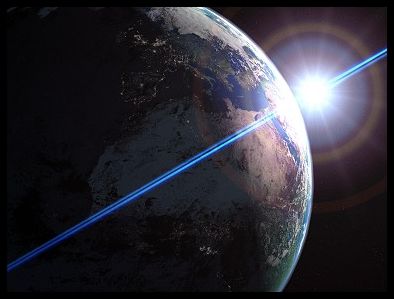--Radius = 0.87 Solar Radii
Alpha Centauri A & B and Proxima Centauri are potentially habitable
The Local Solar Neighborhood
Local Stellar Populations
About 70 stars within 5 parsecs.
About 0.1 stars per cubic parsec
Main Sequence Stars
Fraction of main-sequence stars:
O Stars -- 0.001%
B Stars -- 0.1%
A Stars -- 1%
F Stars -- 2%
G Stars -- 7%
K Stars -- 15%
M Stars -- 75%
The majority of stars are M dwarfs.
Thin disk
Above about 100 pc, number of stars begins to decline in certain directions
The Milky Way
Diffuse band of light crossing the night sky
Our names are derived from Greek and Latin:
--Greek: Galaxias kuklos = "Milky Band"
--Latin: Via Lactea = "Road of Milk"
Properties of Our Milky Way
A flattened disk of stars with a central bulge
Sun is ~8 kpc from the center in Sagittarius
~30 kpc in diameter and ~1 kpc thick
Galactic Center and much of the disk is obscured by dust in the plane of the Galaxy
The Galactic Bulge
Roughly spherical population of stars
Most stars are older than those near the sun
--~10 Gyr old (almost as old as the Universe!)
Much denser
--~100 stars per cubic parsec
Lots of stars
--Tens of billion stars!
There are over 200-400 billion stars in the Milky Way.
Nearby Galaxies
Closest Galaxies are the large and small Magellanic clouds (LMC and SMC)
-- Large Magellanic cloud only has ~one tenth of the stars in the Milky Way
Andromeda Galaxy
Closest massive Galaxy like the Milky Way
Slightly bigger than the Milky Way
Local Group of Galaxies
Dominated by the Milky Way and Andromeda
Dozens of additional small Galaxies like the LMC and SMC
It's A Big Universe
How Many Galaxies?
The Hubble Ultra Deep Field (HUDF) was only one tenth the diameter of the Moon.
Would take ~80 HUDFs to cover the Moon.
Would take ~10 million HUDFs to cover the sky!
HUDF has 10,000 Galaxies
The total number of Galaxies is 10,000 times 10 million ~ 100 billion.
How Many Stars in the Universe?
~100 billion Galaxies
~100 billion stars per Galaxy
Total number of stars in the Universe is: 100 billion times 100 billion ~ 10 billion trillion!
See A Note about Graphics to learn
why the graphics shown in the lectures are generally not reproduced with
these notes.
[
Return to the Astronomy 141 Main Page
|
Unit 4 Page
]
Copyright © Scott Gaudi All Rights
Reserved.

